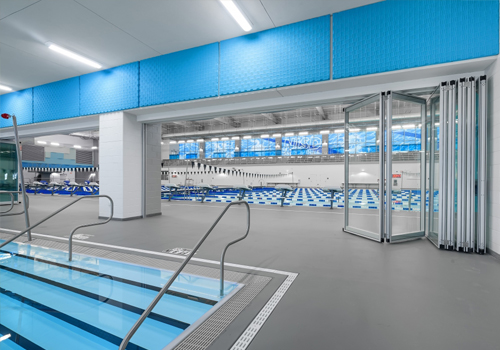Indoor Reverberation Soundproofing
We design and install well-engineered noise control products to decrease and prevent commercial reverberation.
Indoor Pools and Waterparks
Memtech Acoustical has cost-effective solutions to reduce noise levels in pool areas, using mold and mildew resistant materials.
Swimming pools and indoor water parks are popular family venues. Activities such as swimming lessons, kayaking, SCUBA diving instruction and aquatic exercise have become increasingly popular. In many cases, clear communication between swimmers, lifeguards and instructors may be difficult due to excessive reverberation in these facilities, which is also a cause of high overall background noise levels. In team sports, such as water volleyball, it is also important that the players communicate well with each other and can understand the coach’s instructions. Quite often, when children are present, their yelling and laughing can result in noise levels exceeding ‘hearing damage’ limits. Sound at this level can become overwhelming, and discourage participation.
The design and materials used for indoor pool facilities frequently contributes to excessive reverberation: cement walls, tile floors, glass barriers and other hard, flat surfaces are excellent ‘noise reflectors’. Theses surfaces result in high levels of reverberant sound energy throughout the facility. In some instances, pumps and filters can also contribute to high ambient noise levels. These systems can be quieted by the installation of sound-blocking materials such as mass loaded vinyl or ventilated acoustic enclosures.
MEMTECH ACOUSTICAL has cost-effective solutions to reduce noise levels in pool areas, using mold and mildew resistant materials designed to match any décor. These products remain very effective in high-moisture environments, and will not discolor over time. A wide variety of noise-absorbing products are available in a large selection of colors and designs. Soundproofing materials can be hung from the ceiling, or placed around the perimeter of the room. As a rule of thumb, the greater the amount of surface area that is treated, the better the overall performance; however, the use of ‘acoustic clouds’ attached to the ceiling can serve to ‘break-up’ reflected sound very effectively. These clouds come in many shapes, and can add a colorful appearance to the room.


